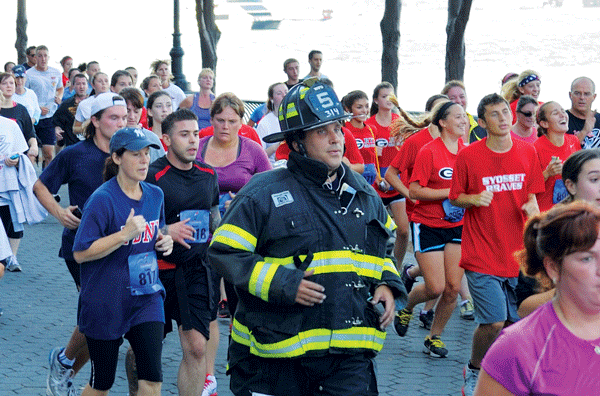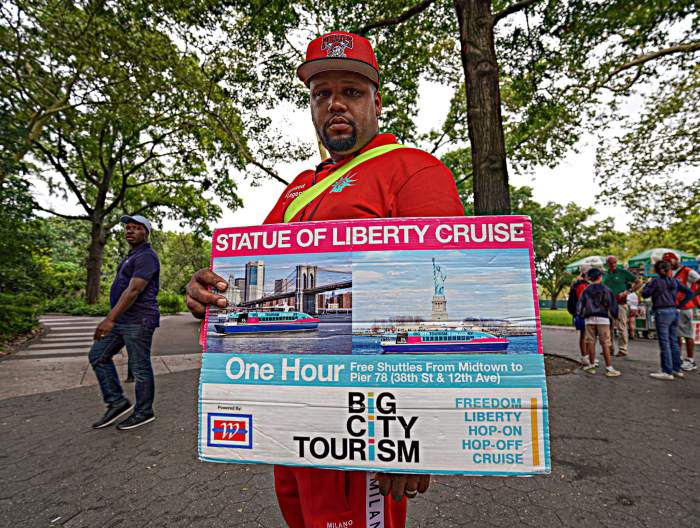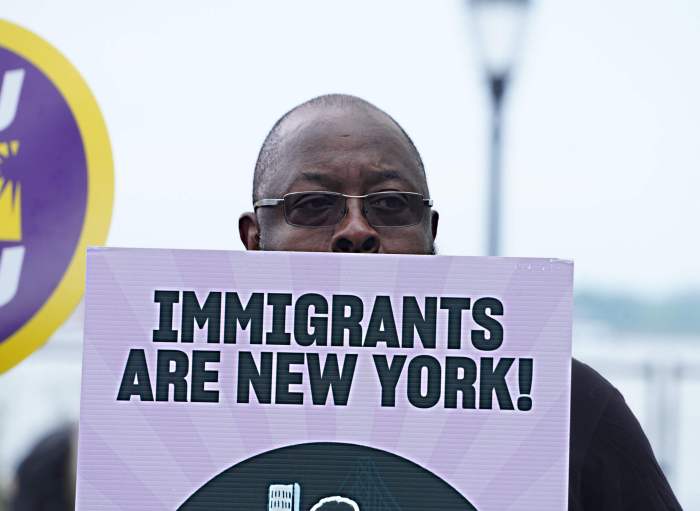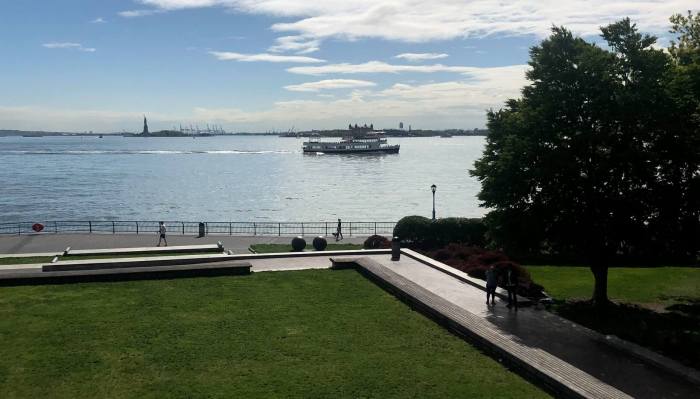Tunnel to Towers Run:
Battery Park City is a popular place for fundraising events, but few of them compare in size to the annual Stephen Siller Tunnel to Towers Run. This year on Sun., Sept. 30, a record number of 28,000 runners and an estimated 7,000 spectators showed up. The run, now in its 11th year, honors firefighter Stephen Siller, who died on 9/11 at the age of 34. He was off duty that day when he heard that the World Trade Center had been attacked. Immediately, he went to his firehouse in Brooklyn for his firefighting equipment. When his car was blocked from entering the Brooklyn-Battery Tunnel, he ran through it on foot carrying 75 pounds of gear on his back.
The run, started by Siller’s family, replicates his route, starting in Red Hook, Brooklyn and ending 3.1 miles away on West Street just south of Chambers Street. The runners, who range in age from 8 to 80, come from all over the country and the world. Some are firefighters themselves who run wearing their gear just as Siller did. Members of all branches of the military participate, and running alongside them are veterans who were grievously wounded in combat. Some of the veterans run on artificial feet, while others push themselves along in wheelchairs or are pushed along because they no longer have legs or arms.
The Tunnel to Towers Run raises money for charities including Building for America’s Bravest, which constructs customized, fully furnished homes known as smart houses that are equipped with easy-to-operate amenities for the badly wounded veterans. Three of these houses, which cost around $500,000 each, have been finished, and five others are almost finished. The money also goes to burn centers and to the families of military personnel who were killed in Iraq and Afghanistan.
Some Battery Park City residents find the Tunnel to Towers Run to be a big inconvenience. Streets are closed, bus stops have to be moved and the event creates litter and noise. But many residents who are aware of Siller’s sacrifice and saw at the race strong young men and women in their prime and veterans who lead difficult, painful lives accepted the temporary hassles.
There are now more than 60 Stephen Siller Tunnel to Towers fundraising runs in various parts of the United States and abroad in Afghanistan, England and Turkey. The original run took place in B.P.C. — no place is more moving to those who were there or knew those who were there on 9/11.
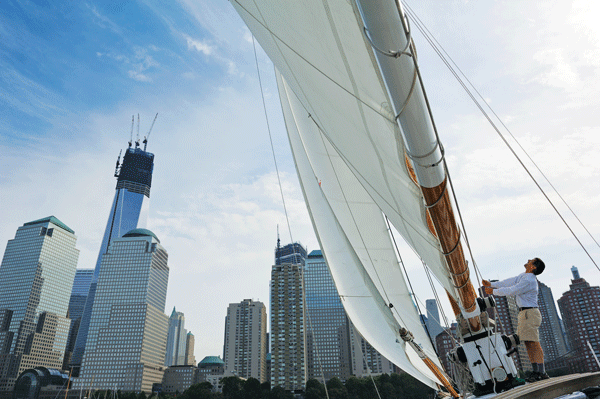
New York Classic Week: Abetted by strong winds, seven stunning sailboats scooted around New York harbor the first weekend of October during the annual New York Classic Week Schooner Race, organized by the New York Harbor Sailing Foundation under the direction of North Cove Marina’s Commodore Michael Fortenbaugh.
On Sat., Oct. 6, the yachts raced from North Cove to the Verrazano-Narrows Bridge and back. The next day, they sailed to the Statue of Liberty, and on Mon., Oct. 8, they circumnavigated Governors Island.
America II, which raced for the America’s Cup trophy in 1987 and which now belongs to the New York Harbor Sailing Foundation, won on Saturday. Black Watch, which was built in 1938 for the Schaefer family of Larchmont, N.Y. and was completely refurbished by the New York Yacht Club, its current owners, won on Sunday and Monday.
The Adirondack and America 2.0, which sailed for the Classic Harbor Line, also participated, as did the Salty and the Irie. Salty has been owned by the same family for the last 43 years. Tiny Irie, only 15 feet long, was built on the small island of Bequia in Saint Vincent and the Grenadines. According to Fortenbaugh, the schooner race was the first time a boat from Bequia sailed around the Statue of Liberty. The owner, David Taylor, also from Bequia, reportedly celebrated back at the dock with a couple of beers.
On Sun., Oct. 7, Ticonderoga, one of the nation’s most famous yachts, sailed in the race. Launched in 1936, the vessel finished first in 24 of her first 37 races and holds more than 30 course records.
Asphalt Green Battery Park City still in limbo: More than a month has passed since it came to light that contractual issues with Asphalt Green have been partly responsible for holding up the opening of the Battery Park City Community Center at 212 North End Ave. The Battery Park City Authority, which underwrote the construction of the $55 million center, has also cited permitting problems as a cause for the delay. The community center was originally supposed to open last November. In anticipation of the opening, many people began paying membership dues starting the previous June.
Community Board 1’s Battery Park City Committee meeting on Tues., Oct. 2, Battery Park City Committee co-chair George Calderaro initiated a discussion about the situation. After mulling it over for around 30 minutes, the committee decided to draft a resolution to present to the full board at its next meeting on Tues., Oct. 23. The resolution will express the committee’s dismay at the “lack of transparency” from both the B.P.C.A. and Asphalt Green with regard to the underlying issues surrounding the center’s long-delayed opening.
The committee wants the B.P.C.A. and elected officials to work together to expedite the opening. It also wants the B.P.C.A. and Asphalt Green to publicly address the contractual issues that divide them and to speedily come to a resolution.
Concerns about the usage of the B.P.C. ball fields are a part of that resolution. In January 2010, C.B. 1 approved a memorandum of understanding (M.O.U.) with the B.P.C.A. stating that only one-third of the ball field space would be used by the community center. C.B. 1 wants assurance that this agreement will be honored.
In addition, the B.P.C. Committee has asked the board’s office to contact the city Department of Buildings and the Fire Department to get information from them directly about outstanding permitting issues.
Former Downtown Little League director Mark Costello, a member of the board’s B.P.C. Community Center Task Force, has additional concerns that other board members share. “If the Battery Park City Authority is attempting to renegotiate the finances with Asphalt Green, it may be the right thing to do from the Authority’s perspective,” he said, “but there’s a social cost that’s not getting talked about.”
The Asphalt Green membership fees and programs announced months ago are expensive, Costello remarked. People with a C.B. 1 zip code shouldn’t be kept from using the community center because they can’t afford it. “It has to be said repeatedly that this is a priority,” he said. “It should be in writing.” The management agreement between the B.P.C.A. and Asphalt Green is explicit as to what kinds of flowerpots Asphalt Green can use, Costello noted, but it says nothing about affordable senior programs, for example.
–– By Terese Loeb Kreuzer
To comment on Battery Park City Beat or to suggest article ideas, e-mail Terese Loeb Kreuzer at TereseLoeb10@gmail.com.



